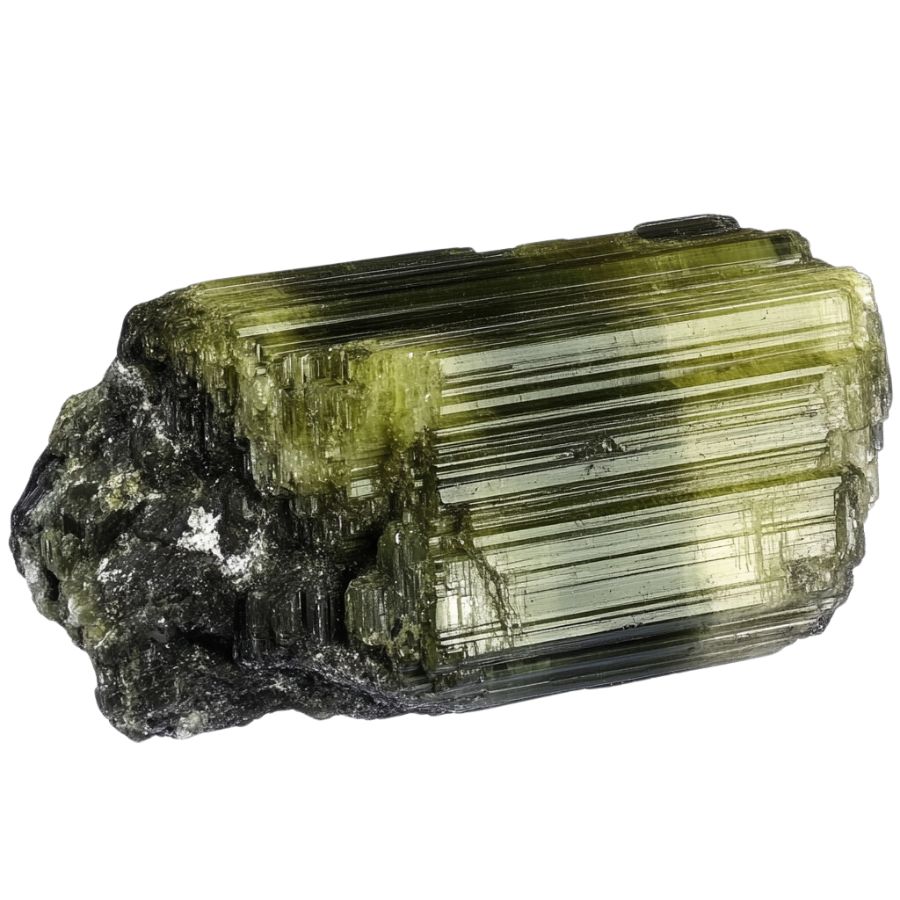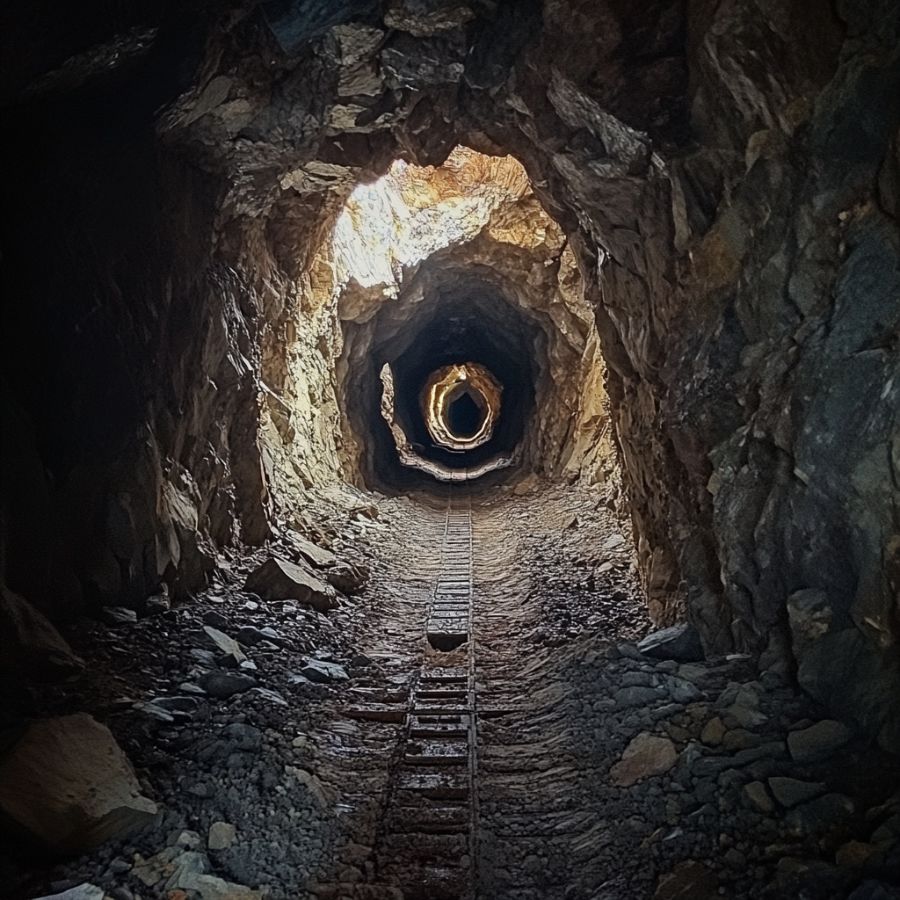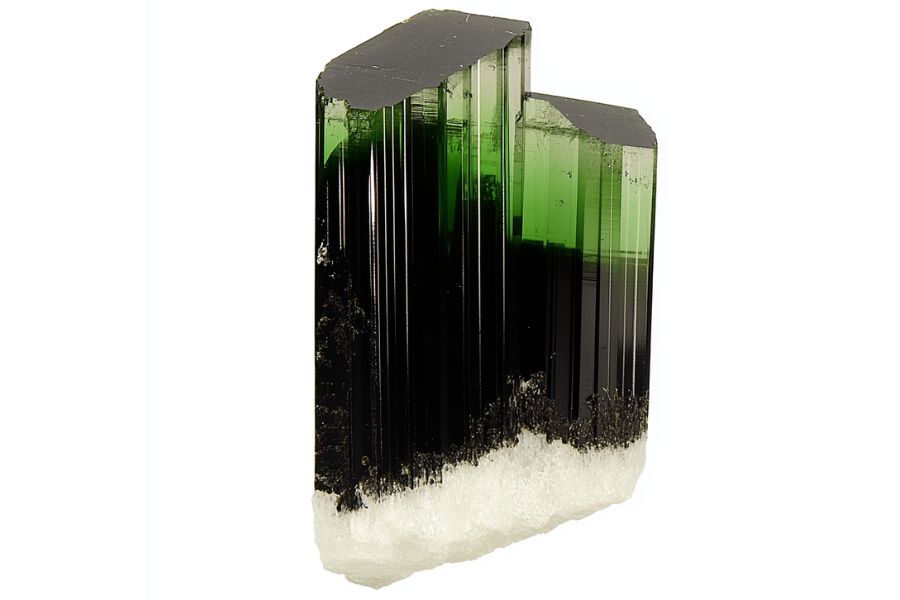From the Sierra Nevada mountains to the Great Basin Desert, from the Colorado River to the high plains of Oregon, Nevada offers a treasure trove for rockhounds.
But finding tourmaline can be frustrating and time-consuming. Many adventurers spend hours searching fruitlessly, unsure where to begin.
Don’t worry – we’ve done the hard work for you. Today, we’ll reveal the best spots to uncover tourmaline in the Silver State.
We’ve consulted local experts and seasoned collectors to bring you a curated list of prime locations. Say goodbye to wasted trips and hello to successful gem hunting.
How Tourmaline Forms Here

Tourmaline forms deep underground through intense heat and pressure. It originates from hot, mineral-rich fluids that move through fractures in rocks like granite and pegmatite. As these fluids cool, the minerals within them start to crystallize, forming tourmaline.
The color of tourmaline depends on the specific minerals involved, leading to a wide range of hues including pink, red, green, and blue.
Over millions of years, these crystals grow and become the beautiful, multifaceted stones we see today. Tourmaline is prized for its variety of colors and is often used in jewelry and decorative items.
The Types Of Tourmaline
Several incredible types of Tourmaline can be found in the US as well as in our state. Each is uniquely beautiful and interesting including:
Elbaite

Elbaite is found in pink, red, green, blue, yellow, and even colorless forms. What makes elbaite special is its ability to show multiple colors in a single crystal, like the famous “watermelon” tourmaline with pink and green hues.
This gem stands out due to its complex chemical makeup, which includes lithium, sodium, and aluminum. This composition gives Elbaite its diverse color range and dichroism, allowing it to display different colors when viewed from different angles.
Elbaite has a unique place in history as the first tourmaline variety in which lithium was discovered back in 1818. Some rare types, like the neon blue Paraiba elbaite, are highly sought after by collectors and jewelers.
Schorl

Schorl is known for its deep, rich color. It typically forms long, prismatic crystals with a shiny, glass-like surface when polished. Unlike other tourmalines, schorl gets its distinctive black color from high iron concentrations.
One of Schorl’s most fascinating features is its ability to become electrically charged through heating or rubbing. When charged, it can attract or repel small particles.
This unique electrical property makes Schorl valuable in various industries. It’s used in electronics and manufacturing to control static electricity and electromagnetic interference.
Despite being less colorful than other tourmalines, schorl’s practical applications make it an important and interesting variety.
Rubellite

Rubellite stands out with its vibrant pink to red colors. The most prized ones show a pure, saturated red without any brown or orange hints. This beautiful color comes from manganese in its makeup.
One cool thing about rubellite is its double refraction. It can look like it has two different colors when you view it from different angles.
Dravite

Dravite, or Brown Tourmaline, comes in shades from dark brown to light brown-yellow. It can look a bit like Smoky Quartz, with a semi-see-through quality.
Its crystals are often needle-like or prismatic, with points at both ends. This sets it apart from other tourmalines like the darker schorl or the colorful elbaite.
What makes dravite special is its rich sodium and magnesium content. This sets it apart from other tourmalines. It was first discovered in 1883 and named after the Drava River in Slovenia.
Indicolite

Indicolite is a rare and captivating blue to blue-green stone. It’s prized for its pure, bright blue color, which is considered the rarest within the tourmaline family. The hues can range from light blue-green to deep, rich blue, often with high clarity.
What sets Indicolite apart is its unique optical effects. It shows pleochroism, appearing to change color when viewed from different angles. Some specimens also display chatoyancy, creating a “cat’s eye” effect when cut in a certain way.
Indicolite is sometimes called “Brazilian sapphire” due to its resemblance to the precious gem. However, they’re different minerals.
The increasing demand for blue tourmalines has made indicolite highly sought-after in the gemstone market, appreciated for its beauty and rarity.
Watermelon Tourmaline

Watermelon tourmaline is truly one-of-a-kind. It looks just like a slice of watermelon, with a pink or red center and a green outer layer. This unique look happens because different elements join the crystal at different times as it grows.
These crystals often form in a rounded triangle shape. They’re see-through to somewhat clear and have a glass-like shine. When cut into slices, they really do look like little watermelons!
Cat’s Eye Tourmaline

Cat’s eye tourmaline is known for its mesmerizing chatoyancy effect. This creates a bright band across the stone’s surface, resembling a cat’s eye.
This stone comes in various colors, from green to pink to brown, and is usually semi-translucent to opaque.
What makes this stone special is the perfect alignment of tiny, needle-like inclusions inside it. These scatter light in a unique way, creating that eye-catching effect. It’s quite different from other tourmalines that don’t have this feature.
Unlike other cat’s eye stones, Tourmaline offers a wider range of colors and is often more affordable.
Achroite

Achroite is a rare, colorless variety of tourmaline that looks like a drop of clear water turned to stone. It’s completely transparent, making it unique among tourmalines which usually have color. The name comes from Greek, meaning “without color.”
What’s special about achroite is that it doesn’t change color when viewed from different angles. It means the stone can be cut in many ways without losing its clarity.
Verdelite

Verdelite is known for its beautiful green color. It can range from light green to deep emerald.
One thing that makes verdelite special is that you can find big, clear crystals of it. This isn’t always easy with other gemstones.
People love using verdelite in jewelry because its rich color and interesting light effects make it a popular choice for all kinds of accessories. Each piece of verdelite is like a little piece of nature you can wear.
Paraíba Tourmaline

Paraíba Tourmaline is a rare gemstone that catches the eye with its vibrant neon blue or green color. It’s like no other tourmaline you’ve seen before. The intense glow comes from copper in the stone, making it stand out from its cousins.
This stone is one of the rarest. For every 10,000 diamonds mined, only one Paraíba tourmaline is found.
It was only discovered in the late 1980s, making it a newcomer in the gem world. But Paraíba tourmaline’s unique color and rarity quickly made it a favorite among gem lovers.
Its discovery caused quite a stir in the gem community. Even small stones can be valuable because of how rare and beautiful they are.
What Rough Tourmaline Looks Like
When you’re out looking for rough Tourmaline on your own it’s important to know what you’re looking for. But before we dive into specifically what to look for you need to make sure you understand the type of rocks and minerals you’re seeing.
DON'T MISS OUT ON ANY GREAT FINDS!
While you're out searching for Tourmaline you're going to find A LOT of other interesting rocks and minerals along the way. The last thing you want to do is toss out something really interesting or valuable. It can be easy to misidentify things without a little guidance.
We've put together a fantastic field guide that makes identifying 140 of the most interesting and valuable rocks and minerals you will find REALLY EASY. It's simple to use, really durable, and will allow you to identify just about any rock and mineral you come across. Make sure you bring it along on your hunt!
Now, back to the identification specifics:
Here are some tips to help you recognize rough tourmaline.
Look for Color Variations

Tourmaline comes in many colors, like pink, green, blue, and even black. Some pieces have multiple colors, like watermelon tourmaline, which is pink and green.
If you see these color mixes, it’s likely tourmaline. Keep an eye out for vibrant shades.
Assess the Density and Weight

Rough tourmaline is relatively heavy for its size. If you pick up a piece and it feels denser than expected, it could be tourmaline. This weight can help you confirm your find.
Examine the Crystal Structure

Tourmaline features distinctive crystal shapes, ranging from slender and elongated to chunky forms. Look for triangular cross-sections and striations on the surface, which indicate its unique growth patterns.
Check for Transparency

Some rough tourmaline can be slightly transparent. If you hold it up to the light, you might see through it a bit. This transparency can be a good sign that you have tourmaline.
A Quick Request About Collecting
Always Confirm Access and Collection Rules!
Before heading out to any of the locations on our list you need to confirm access requirements and collection rules for both public and private locations directly with the location. We haven’t personally verified every location and the access requirements and collection rules often change without notice.
Many of the locations we mention will not allow collecting but are still great places for those who love to find beautiful rocks and minerals in the wild without keeping them. We also can’t guarantee you will find anything in these locations since they are constantly changing.
Always get updated information directly from the source ahead of time to ensure responsible rockhounding. If you want even more current options it’s always a good idea to contact local rock and mineral clubs and groups
Tips on where to look
Once you get to the places we have listed below there are some things you should keep in mind when you’re searching:
Look for Sedimentary Rocks

Sedimentary rocks are great places to find tourmaline. These rocks form from layers of sand, mud, and minerals. Over time, minerals like tourmaline can get trapped.
Look in riverbeds or areas where sediment has built up. You might find small pieces or even larger crystals.
Explore Mines

Mines are great spots to find tourmaline. Many mines across the U.S. extract various gemstones, including tourmaline.
Some mines even allow visitors to search for gems themselves. Always check if they have guided tours or special digging days.
Search in Gravel Pits

Gravel pits are often overlooked, but they can be treasure troves. These pits dig deep into the earth, exposing layers of rock.
Tourmaline can be found in the gravel. Just sift through the material carefully.
Some Great Places To Start
Here are some of the better places in the state to start looking for tourmalines:
Always Confirm Access and Collection Rules!
Before heading out to any of the locations on our list you need to confirm access requirements and collection rules for both public and private locations directly with the location. We haven’t personally verified every location and the access requirements and collection rules often change without notice.
Many of the locations we mention will not allow collecting but are still great places for those who love to find beautiful rocks and minerals in the wild without keeping them. We also can’t guarantee you will find anything in these locations since they are constantly changing.
Always get updated information directly from the source ahead of time to ensure responsible rockhounding. If you want even more current options it’s always a good idea to contact local rock and mineral clubs and groups
Ruby Mountains

The Ruby Mountains in Elko County, are a stunning mountain range located in the northeastern part of the state within the Humboldt-Toiyabe National Forest.
Often called the “Swiss Alps of Nevada,” this 80-mile mountain range boasts glaciated peaks, alpine lakes, and lush meadows. Tourmaline has been discovered here, making it a promising spot for gem enthusiasts.
The Ruby Mountains’ unique geology stems from ancient glacial activity, which carved deep canyons and exposed a variety of minerals.
This glacial action has created ideal conditions for gemstone formation, including tourmaline. The range is also known for garnets, giving it its ruby-inspired name.
For the best tourmaline hunting, head to the high-elevation areas along the Ruby Crest Trail. This 43-mile path offers access to numerous alpine lakes and streams where gems might be hiding.
The Lamoille Canyon Scenic Byway is another great starting point, leading to several promising rockhounding sites.
Pony Canyon

Nestled in the heart of Nevada’s Reese River Mining District, Pony Canyon in Lander County beckons rockhounds with its rich geological history.
This rugged canyon, once a hotspot during the 1860s silver rush, now offers a treasure trove for tourmaline enthusiasts. The area’s quartz veins, remnants of its mining past, hold the key to finding these colorful gems.
Tourmaline can typically be found in the quartz veins scattered throughout the canyon. These veins are often located in the walls of the canyon and in the tailings left from historical mining operations.
The canyon’s unique geology, shaped by ancient volcanic activity, creates an ideal environment for mineral formation. Beyond tourmaline, you might stumble upon other minerals like pyrite or galena.
Tom Cat Prospect

Tom Cat Prospect is located near Round Mountain, on the eastern slope of the Toiyabe Range, south of the South Twin River. It’s a geological wonderland where rhyolite dikes meet metamorphic rocks, creating a rich environment for mineral formation.
The prospect’s claim to fame is its complex contact zones. Here, silicified shear zones host a variety of sulfides, including pyrite and galena.
These areas are prime spots for finding tourmaline, often nestled among quartz veinlets. The diverse mineral content makes each dig an exciting adventure.
While searching, keep an eye out for the telltale signs of mineralization. The contrast between the light-colored rhyolite and darker metamorphic rocks can guide you to promising areas.
McCoy Creek Group

Located along the eastern slope of the Schell Creek Mountains in White Pine County, the McCoy Creek Group offers a unique geological treasure trove for rockhounds.
This area, part of the Great Basin region, is known for its diverse lithology, including quartzite, phyllite, schist, and marble.
The thick sequence of siliceous and argillaceous metasediments, transformed by low to medium-grade regional metamorphism, creates an ideal environment for mineral formation.
Tourmaline enthusiasts will find this location particularly rewarding, as the crystals often form in pockets and veins within the metamorphic rocks.
The area’s rugged terrain and scenic vistas add to the allure of the hunt, making it a favorite among both novice and experienced gemstone seekers. While exploring, keep an eye out for other minerals that call this geologically rich area home.
Blind Mountain

Blind Mountain is part of the Highland Range, which is located in the southwestern part of the state. The Highland Range is surrounded by other notable ranges such as the Bristol Range to the north and the Chief Range to the south
This rugged terrain, part of the historically rich Pioche silver mining district, offers a unique opportunity to uncover tourmaline. The mountain’s geology, shaped by ancient volcanic activity, has created diverse mineral deposits that make it a prime spot for gemstone hunters.
Within Blind Mountain, tourmaline can typically be found in the old mine workings and surrounding rock formations. The best spots are often near the surface where erosion has exposed mineral veins.
The area’s volcanic past has left behind a variety of rock formations, making each expedition an exciting geological adventure.
Places Tourmaline has been found by county
After discussing our top picks, we wanted to discuss the other places on our list. Below is a list of the additional locations where we have succeeded, along with a breakdown of each place by county.
| County | Location |
| Churchill | Afterthought Area |
| Churchill | Fireball Ridge Prospects |
| Clark | Santa Cruz Mine |
| Douglas | Utopian Mine |
| Elko | Dawley Canyon area |
| Humboldt | Chimney Creek Mine |
| Humboldt | Twin Creeks Mine |
| Lander | 39A zone in Robertson – Triplet Project |
| Lander | Watt mine |
| Lyon | Ann-Mason deposit |
| Lyon | Anaconda’s Yerington open pit |
| Lyon | Mason Valley Mine |
| Mineral | Luning area |
| Mineral | Silver Chief Mine |
| Mineral | Giroux group in Santa Fe District |
| Mineral | Mineral Jackpot Prospect |
| Nye | Keyser Mine |
| Nye | Victor Mine |
| Nye | East Zone deposit |
| Nye | Royston Cu deposit |
| Nye | Enriquez Prospect |
| Nye | Outlaw Mine |
| Nye | Buffalo Canyon prospect |
| Pershing | NBMG Sample Site 2907 |
| Pershing | Jamesonite Prospect |
| Pershing | Raven Prospect |
| Pershing | Kaiser Bill Prospect |
| Pershing | Limerick Canyon Prospect |
| Pershing | Crusoe Canyon |
| Washoe | Pyramid Lake Copper Prospect |
| Washoe | Spanish Springs area propspects |
| Washoe | Black Rock Desert |


